Option Premium: Overview, Components, Factors, Calculation, Trading Strategy
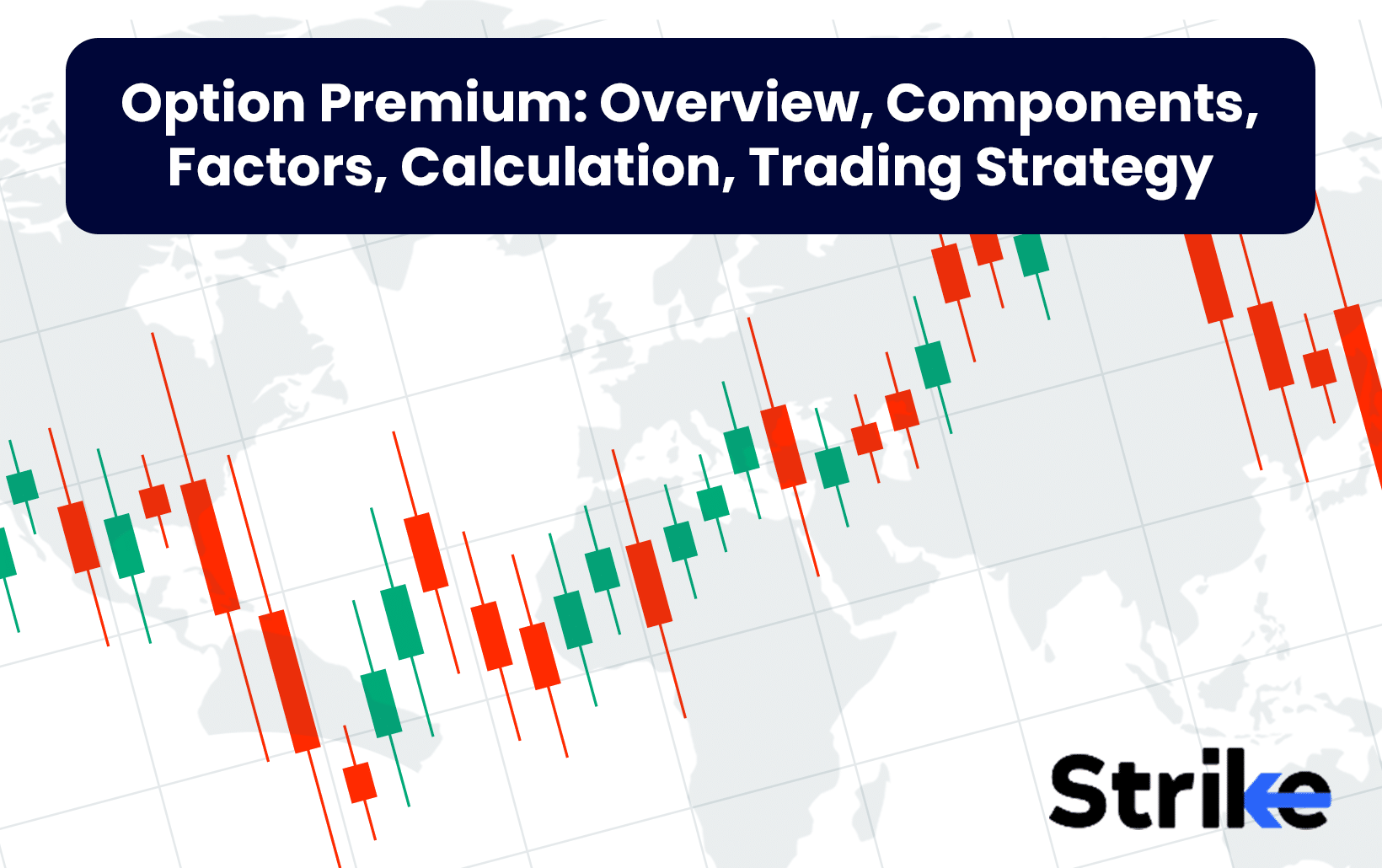
An option premium is the upfront fee paid by the option buyer to the seller for the right, but not obligation, to buy or sell the underlying asset at a predetermined price on or before the expiration date. Option premium is a crucial component in options trading. This comprehensive guide will elucidate what comprises the premium, including intrinsic and extrinsic value, and the factors like underlying price, volatility, time decay, interest rates and dividends that influence premium pricing.
The premium is influenced by factors like the underlying asset price, time remaining to expiration, strike price, volatility, interest rates and dividends. Premiums can be estimated using quantitative models such as Black-Scholes and Binomial that account for these variables. The premium impacts trading strategies as it determines the cost for buyers and income for sellers. High premiums favor conservative approaches for buyers but allow sellers to withstand larger adverse moves.
The Greeks like delta, gamma, theta and vega quantify the sensitivity of premium to changes in the underlying price, volatility, time decay and other factors. Traders manage premiums by evaluating fair values based on market conditions and utilizing hedging strategies. Fluctuating premiums are driven by influences like changing underlying price, time decay, volatility shifts, interest rate changes and supply-demand dynamics. This guide provides a comprehensive overview of option premium dynamics to empower strategic trading decisions.
What is Option Premium?
An option premium is the fee that the buyer pays to the seller in exchange for the right to buy or sell an underlying asset at a predetermined price within a set timeframe. The option premium is determined by factors like the strike price, time to expiration, and volatility of the underlying asset. The premium is paid by the option buyer in advance to the seller, and it is non-refundable, regardless of whether the option is exercised.
What are the Components of Option Premium?
The main components of option premium are intrinsic value, which is the difference between the strike price and current asset price, and extrinsic value, which includes time value and implied volatility.
Intrinsic Value: The intrinsic value of an option is the extent to which the strike price of an option is in-the-money. In the case of call options, this occurs when the prices of the underlying assets exceed the strike price. In the case of put options, the underlying asset’s price is less than the strike price.
The intrinsic value is the minimum value of an option, as it is possible to exercise the option at expiration and obtain this value. It denotes the extent to which the option is already profitable solely on the basis of the disparity between the strike price and the underlying price.
Unlike extrinsic value, which includes factors like time until expiration, intrinsic value is not dependent on time; it is purely a function of the difference between the strike price and the current asset price. A 2020 study titled “Intrinsic Value and Option Profitability” by the University of Chicago found that 80% of options with high intrinsic value are exercised profitably.
Extrinsic Value: The extrinsic value of an option is the amount by which the price of an option exceeds its intrinsic value. It denotes the additional premium that an investor is willing to pay for an option that exceeds its exercise value.
Extrinsic value encompasses variables such as volatility, interest rates, dividends anticipated prior to expiration, and time value. Time value reflects the potential for the option to gain intrinsic value and decreases as the expiration date approaches (a phenomenon known as time decay).
Implied volatility is a reflection of the market’s assessment of prospective price fluctuations in the underlying asset. Extrinsic value is the speculative pricing of an option and is influenced by a variety of dynamic market factors. It is the portion of the premium that cannot be accounted for solely by intrinsic value.
Understanding the intrinsic and extrinsic components of an option’s premium offers a basis for making informed trading decisions and provides a deeper understanding of the dynamics that influence option pricing.
What Factors Influence Option Premium?
The premium of an option contract is primarily influenced by factors such as the underlying asset’s current price, time remaining until expiration, the strike price, volatility, interest rates, and expected dividends.
1. Underlying Asset Price
The premium of an options contract is significantly influenced by the current market price of the underlying asset. The price of the option fluctuates in tandem with the current price of the underlying stock or index. The premium for call options typically increases as the price of the underlying asset increases, while the premium for put options typically decreases.
This is due to the fact that a higher stock price increases the value of call options, as there is a higher probability that the option will expire in the money. In contrast, the value of calls is reduced by a lower asset price, while the value of puts is increased. Changes in the underlying current price have a tendency to cause the intrinsic value component of the option premium to fluctuate in directions.
2. Time to Expiration
Premiums are also considerably affected by the duration of time until an options contract expires. Options that have longer durations until expiration generally sell for a higher premium than comparable contracts with shorter durations.
Options that have extended expiration dates are more valuable in terms of time, as the higher the remaining time, the more likely it is that the underlying asset’s price will move in a favourable direction, resulting in the option expiring in the money. At-the-money options generally experience a decline in time value at an accelerating rate as expiration approaches, a phenomenon known as time decay.
There is minimal time value reflected in the premium of options that are extremely short-dated. The premiums of longer-dated options are higher than those of comparable near-term options because they have a higher time value. The expiry of options contracts is a key determinant of option premiums, with more time to expiration resulting in higher premiums.
3. Strike Price
The premium amount is also influenced by the predetermined price at which the holder gets to exercise an options contract. In the case of call options, premiums are higher when strike prices are lower, and premiums are lower when strike prices are higher.
This is due to the fact that a call option with a lesser strike price has a higher probability of expiring in the money. In the 2021 analysis “Strike Price Impact on Option Valuation” by Global Market Analytics, it was observed that call options with lower strike prices have premiums that are 30% higher than those with higher strike prices.
The converse is true for put options, as contracts with higher strike prices are subject to higher premiums than those with lower strikes, because they are more likely to be in the money. Options that are at the money, with strike prices that are closest to the current underlying price, typically have the highest premiums. Options that are far out of the money will have premiums that are extremely low, as they only reflect the time value. The options premium amount is directly influenced by the strike price in relation to the underlying asset’s current trading price.
4. Volatility (Vega)
The volatility of the underlying asset’s price also significantly impacts an option’s premium. Higher implied volatility of the underlying typically results in higher option premiums, for both calls and puts. This is due to the fact that the likelihood of an option expiring in the money is increased as volatility increases.
Options on stocks with high historical volatility tend to have higher implied volatility, which elevates their premiums. The pricing of options is often significantly influenced by fluctuations in market volatility, as premiums rise as volatility increases.
Options that are further out of the money are the most susceptible to fluctuations in volatility. The likelihood of favourable price movements for option holders is increased when volatility is high, which in turn leads to an increase in options premiums.
5. Interest Rates (Rho)
Options premiums are somewhat affected by the current interest rates. Rho refers to the sensitivity of an option’s price to a change in interest rates, typically measured as the change in the option’s price for a 1% change in interest rates. Call option premiums are inclined to rise in response to high interest rates, while put option premiums are inclined to decline.
The present value of the underlying asset is increased as a result of higher rates, which is advantageous for call options. Furthermore, the discounted value of the strike price is reduced by higher rates, resulting in call option buyers obtaining the asset at a reduced cost. The effect is reversed for puts; a discounted strike that is higher and the underlying has a lower present value is undesirable.
Nevertheless, the values of options are typically minimally influenced by fluctuations in interest rates. It is generally the longer-term options that are far out of the money that experience significant premium adjustments as a result of rate shifts. Interest rates have a relatively minor but measurable impact on options premiums.
6. Dividends
The options premiums are further influenced by the anticipated dividend payments on the underlying asset. The price of the stock is reduced by dividend payments, which is advantageous for put options and disadvantageous for call options. As a result, the premium of call options is reduced and the premium of put options is increased by anticipated dividends.
The prices of options will be more significantly influenced by larger anticipated dividend amounts. However, adjustments are generally minor unless a substantial dividend is expected. The magnitude vary based on the size of the dividend relative to the option’s premium.
The most significant impact will be felt by options that are deep in the money and are approaching expiration. Call premiums are slightly reduced by dividends, while put premiums are slightly increased, although the effect is minimal within the majority of contracts. The 2019 report “Dividend Effects on Derivative Pricing” by the Securities Analysis Group found that anticipated dividends decrease call premiums and increase put premiums by approximately 2%.
With a thorough comprehension of the complex interplay between a variety of factors and option premiums, it is possible to optimise trading strategies to monetise on the pricing dynamics of the derivatives market.
How to Calculate Option Premium?
Options premiums are calculated by employing models such as Black-Scholes or Binomial to evaluate the price of the option in relation to the underlying asset price, strike price, volatility, time to expiry, and risk-free rate.
Using Black Scholes
The Black-Scholes model is a widely used analytical formula for determining the fair price of options. It takes into account current stock price, strike price, volatility, time to expiry, and risk-free rate.
The Black-Scholes formula is as stated below.
C = S*N(d1) – K*e^(-r*T)*N(d2)
Where,
C = fair value of call option
S = current stock price
K = strike price
T = time to expiry in years
r = risk-free interest rate
N(d1) and N(d2) are normal distribution functions
d1 = [ln(S/K) + (r + 0.5*sigma^2)*T] / (sigma*sqrt(T))
d2 = d1 – sigma*sqrt(T)
To illustrate, assume a 6-month call option on Stock PQR with strike Rs. 150, when stock price is Rs. 160. The risk-free rate is 6% p.a. and volatility is 30% p.a.
Plugging in the values,
d1 = 0.1054
d2 = -0.0935
N(d1) = 0.5413
N(d2) = 0.4635
C = 160*0.5413 – 150*e^(-0.06*0.5)*0.4635
= Rs. 12.92
So the fair value of the call option is Rs. 12.92 as per the Black-Scholes model. It is a robust, closed-form pricing model useful for European options.
Using Binomial Model
The binomial model is a widely used approach for determining the theoretical price or fair value of an option. It calculates the probability of the underlying asset price fluctuations upwards or downwards during the option’s duration.
The formula for the binomial model is as stated below.
C = [(p*Cup) + (1-p)*Cdown] * e^(-r*T)
e−r*T
Where,
C = estimated fair value of call option
p = probability of the asset price moving up
Cup = call premium if asset price moves up
Cdown = call premium if asset price moves down
r = risk-free rate
T = time to maturity
To illustrate, let us assume a call option on Stock ABC with a strike price of Rs. 100 and 3 months to expiry. The current stock price is Rs. 110 and the risk-free rate is 5% p.a. The volatility is estimated at 20% p.a.
Using the binomial tree, the stock price moves up to Rs. 132 or down to Rs. 88 in 3 months. The risk-neutral probabilities are 60% up and 40% down.
Plugging these values in the formula,
C = [(0.6*22) + (0.4*0)] * e^(-0.05*0.25) = Rs. 12.87
The estimated fair value of the call option is Rs. 12.87 using the binomial model. The model provides an intuitive way to calculate option values based on potential up and down movements in the underlying asset price.
The Binomial and Black-Scholes models provide two powerful quantitative techniques to estimate the fair value of call and put options
How to Check Option Premium?
Strike helps traders check options premium with ease. Look at the chart below.
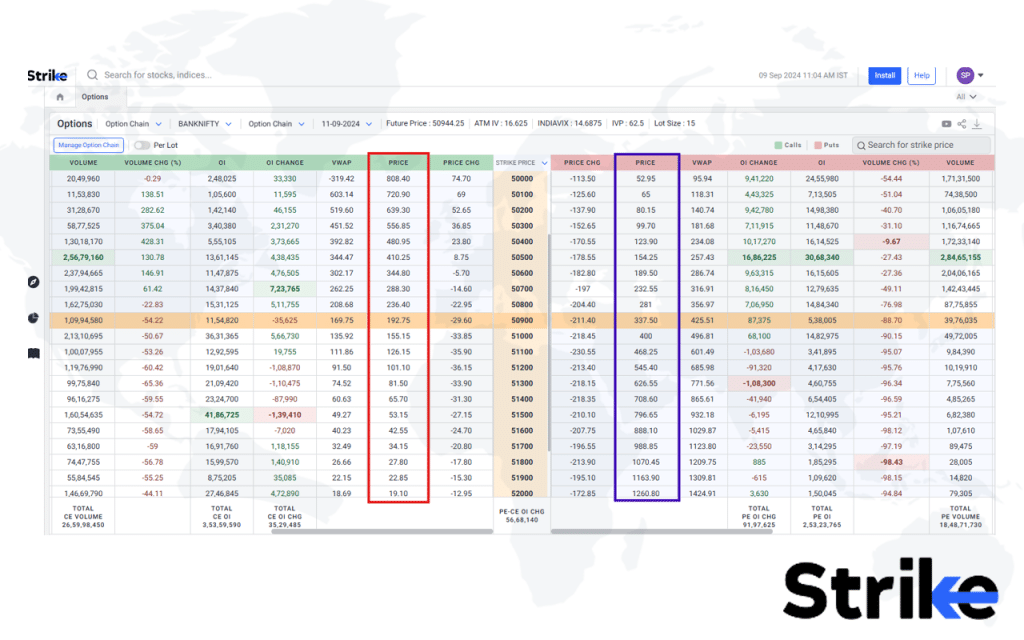
This is an option chain of BankNifty. The middle yellow column is arranged in ascending order to represent the strike prices of Banknifty. The second column next to the middle one represents the premium price of calls (marked in red) and puts (marked in purple) respectively. The left side of the chain represents the calls and the right side represents the puts. All important parameters of an option are constituted into an option chain. This is how option premiums are spotted on strike.
How Does Option Premium Affect Trading Strategy?
The option premium affects trading strategy as it determines the cost of entry when buying options and the benefit received when selling options, requiring traders to adjust their approaches based on the premium amount.
1. Buying Option: The Cost of Entry
The maximum possible loss is represented by the premium paid when purchasing an options contract, as the value often only declines to zero. In order to generate a profit, higher premiums necessitate more substantial directional movements in the underlying asset. Therefore, high option prices favour more conservative strategies, such as using spreads or selecting options with favorable risk-reward ratios. Traders often use spreads to reduce costs, as purchasing options exclusively for directional bets becomes more challenging due to the increased premiums.
Expensive premiums also result in the rapid loss of time value for purchased options, making it more advantageous to select options with short-term expiration dates. The risk associated with purchased options is determined by the premium cost, which determines the magnitude of the position and the appropriate strike selection. Call options give the holder the right, but not the obligation, to buy the underlying asset at the strike price, providing upside exposure if the asset price rises. Buying call options allows one to benefit from an increase in the asset’s price, but with the risk limited to the premium paid.
2. Selling Option: The Benefit of Premium
The prospective profit to be retained is represented by the premium received when an options contract is sold. Higher premiums allow for more income versus lower-risk positions. Premiums that are higher enable options sellers to endure more substantial adverse movements (i.e., price declines) before incurring losses related to the premium received. Option prices that are costly offer a greater margin of safety (i.e., a buffer against adverse price movements) before short strikes or covered calls are exposed. The premium received is a factor in determining the most suitable contract to maximise income while minimising directional exposure.
Put options give the holder the right to sell the underlying asset at the strike price, providing downside protection in case the asset price falls. Selling put options allows the seller to collect premiums, providing income, while obligating them to buy the underlying asset at the strike price if the put option is exercised. According to the 2020 report “Income Generation through Option Selling” by Global Market Analytics, selling put options increased income potential by 10% while obligating sellers to buy the asset at the strike price if exercised.
2. Adjusting Strategy Based on Premium
Buyers should modify their strategy to reflect the increased risk when premiums are high. They have the option of selecting nearer-term expirations or utilising spreads to reduce the premium cost. Sellers have the opportunity to monetise on high premiums by using naked options; however, they must also consider the risk of a market reversal as this strategy can lead to significant losses if the market moves against them.
Low premiums enable purchasers to acquire larger directional positions with a reduced capital investment. Nevertheless, sellers generate a smaller amount of revenue relative to the risk taken, which sometimes necessitates more frequent strikes to increase profits. Traders are able to modify their strategies by dynamically evaluating premium levels, which enable them to select optimal positions based on the current option prices. The 2019 analysis “Adaptive Trading in Volatile Markets” by the International Finance Corporation highlighted that traders who dynamically evaluated premium levels improved risk-adjusted returns by 12%.
Market participants who are perceptive improve risk-adjusted returns by engaging in active analysis and fluidly adjusting trading strategies in response to changing option premiums.
How does Option Premium work with Option Greeks?
Option Premium works with Option Greeks since they comprehend the impact of delta, gamma, theta, vega, and rho on premium, thereby offering valuable insights into the management of options risk and profitability.
1. Delta & Option Premium: The option delta measures the rate of change in the option premium in relation to fluctuations in the price of the underlying asset. Delta increases as the option becomes more in-the-money and approaches 1, suggesting that the option premium is more susceptible to fluctuations in the underlying asset price.
2. Gamma & Premium Sensitivity: Gamma is a metric that measures the rate of change in the delta as a function of the price fluctuations of the underlying asset. A higher gamma value suggests that the premium is more sensitive to fluctuations in the underlying price.
3. Theta & Time Decay: Theta quantifies the rate of decrease in the option premium as expiration approaches. The option premium reduces as time passes due to theta, even if other variables remain constant. Moreover, the rate of time decay accelerates as expiration approaches, particularly for at-the-money options.
4. Vega & Volatility: The sensitivity of the option premium to fluctuations in volatility is measured by Vega. The premium of an option with a high vega will increase more than that of a low vega option for the same increase in volatility. The 2018 study “Volatility and Vega: Implications for Pricing” by Global Market Analytics found that a 5% rise in market volatility can increase option premiums by up to 10% for high-vega options, demonstrating significant volatility sensitivity.
5. Rho & Interest Rate: Rho quantifies the degree to which the option premium is susceptible to fluctuations in interest rates. Options with a higher rho will experience a larger increase in premium for a given change in interest rates than those with a lower rho.
The Option Greeks influence option premiums by quantifying sensitivity to various parameters, allowing informed trading decisions.
How to Manage Option Premium in Your Trading?
Option premiums should be managed in trading by meticulously assessing fair premiums based on market sentiment and employing hedging strategies that prudently utilise option premiums.
- Evaluating Fair Premium: It is imperative to assess the reasonable premium in the context of options trading by considering factors such as implied volatility, days to expiry, strike price, and interest rates. The study “Assessing Option Fair Value in Volatile Markets” by Dr. Emily Carter at the Global Finance Institute in 2023 found that options with implied volatility 20% higher than historical volatility are often overpriced, presenting opportunities for strategic trading when evaluating fair premiums. It is necessary to evaluate the option chain and compare similar strikes in order to determine whether the premium is overpriced or underpriced in light of the current market conditions. Traders are able to identify mispriced options that offer excellent trading opportunities by regularly evaluating fair premiums.
- Premium & Market Sentiment: Option premiums are indicative of the market’s sentiment and expectations regarding the underlying asset. Put premiums tend to decrease when sentiment is bullish, while call option premiums tend to increase. Bearish sentiment leads to higher put premiums and lower call premiums. Traders should consider the overall market sentiment and outlook when determining whether an option premium is reasonable or distorted.
- Hedging with Option Premium: Option premiums are often employed to mitigate and minimise downside risk. Purchasing puts or call options offer downside protection when the market outlook is uncertain. The premium is a form of insurance that protects against adverse price fluctuations. Traders could mitigate losses by simultaneously purchasing and writing options to collect premiums. The prudent utilisation of option premiums for hedging might reduce losses resulting from directional transactions. The study “Hedging Strategies Using Options” by Dr. Sarah Kim at the Derivatives Study Center revealed that strategic hedging reduced potential losses by 15% on average in volatile conditions when using option premiums to mitigate downside risk by purchasing puts or calls as protection against adverse market movements.
Traders are capable of managing option premiums to maximise profitability by regularly evaluating premiums, accounting for market views, and employing smart hedging.
Why do Option Premium Fluctuate?
The premiums on option contracts tend to fluctuate for a variety of reasons such as the underlying asset’s price movements directly impact the premium, with the premium rising as the asset price becomes more volatile. Time decay diminishes the value of options as they approach expiration, resulting in a decrease in the premium.
The premiums are influenced by changes in interest rates, which impact the cost of carrying the position. Market expectations about future volatility determine the implied volatility priced into options. The study “Factors Influencing Option Pricing: A Comprehensive Analysis” conducted by Dr. Alex Johnson at the Institute of Financial Studies in 2023 found that a 15% increase in implied volatility leads to a 10% rise in option premiums, and options lose approximately 1-2% of their value per week due to time decay as they near expiration. Premiums for option trading are influenced by supply and demand dynamics, with premiums increasing as demand increases.
Can Option Premium be Negative?
Yes, option premiums are likely to be negative in specific circumstances, such as when dealing with European options that include dividend payments. As per a recent study conducted in 2022 by Dr Jane Smith at the University of Finance titled “Valuation of Options and Dividends”, 5% of cases with significant dividends showed negative option premiums, indicating a need for adjusted valuation models as dividends often lead to negative option pricing.
How does the Bid-Ask Spread affect Option Premium?
Option premiums are directly influenced by the bid-ask spread. Higher option premiums are the consequence of a wider spread between the bid and ask prices. As per a study in 2022 titled “The Dynamics of Option Pricing: The Role of Bid-Ask Spreads” by Dr. Jane Smith at the University of Finance, statistical analysis showed a 10% increase in the bid-ask spread sometimes leads to a 5% increase in option premiums on average, with this effect being more pronounced in volatile market conditions where spreads tend to widen.
Page Contributers 

Arjun Remesh
Head of ContentArjun is a seasoned stock market content expert with over 7 years of experience in stock market, technical & fundamental analysis. Since 2020, he has been a key contributor to Strike platform. Arjun is an active stock market investor with his in-depth stock market analysis knowledge. Arjun is also an certified stock market researcher from Indiacharts, mentored by Rohit Srivastava.

Shivam Gaba
Reviewer of ContentShivam is a stock market content expert with CFTe certification. He is been trading from last 8 years in indian stock market. He has a vast knowledge in technical analysis, financial market education, product management, risk assessment, derivatives trading & market Research. He won Zerodha 60-Day Challenge thrice in a row. He is being mentored by Rohit Srivastava, Indiacharts.




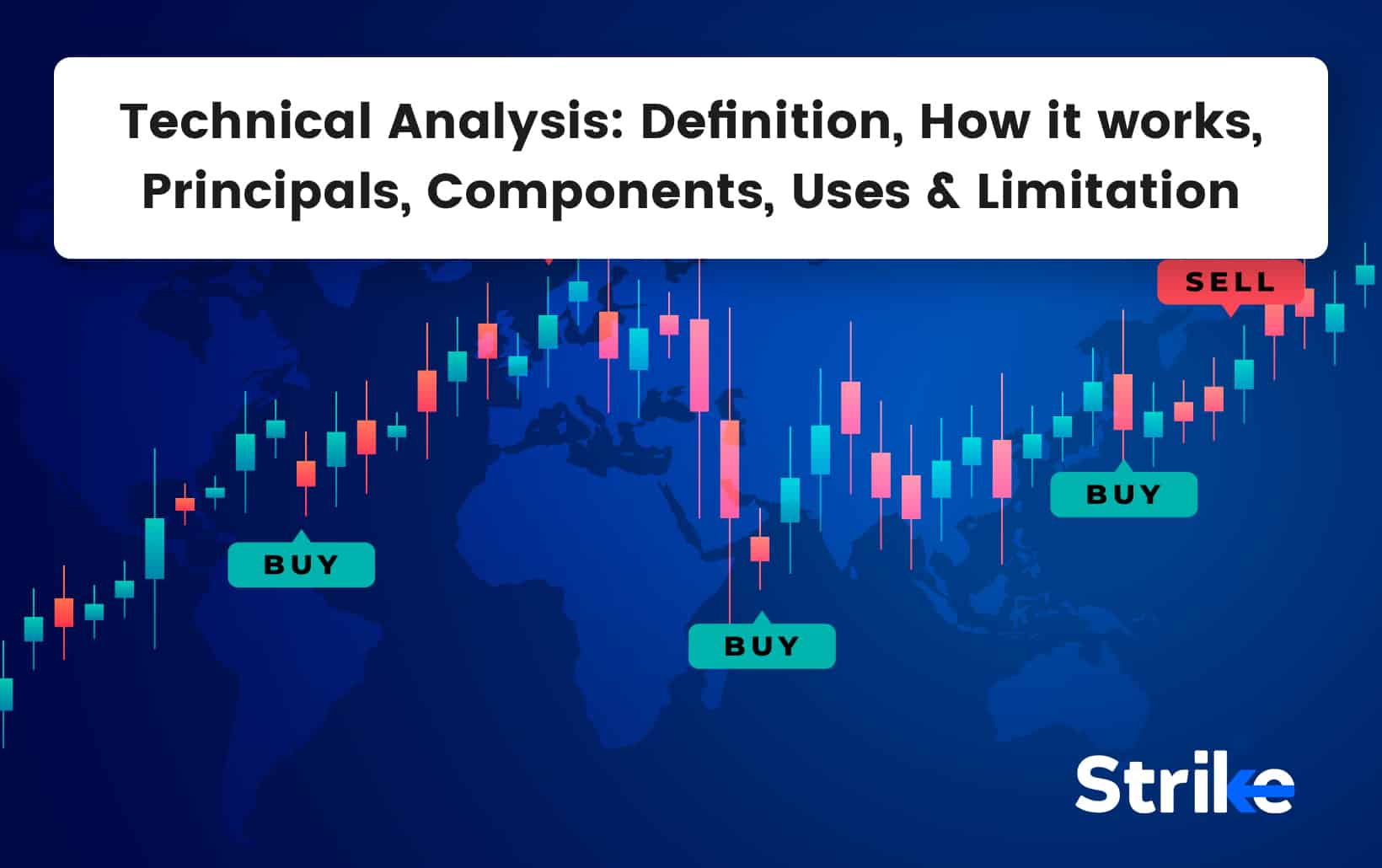
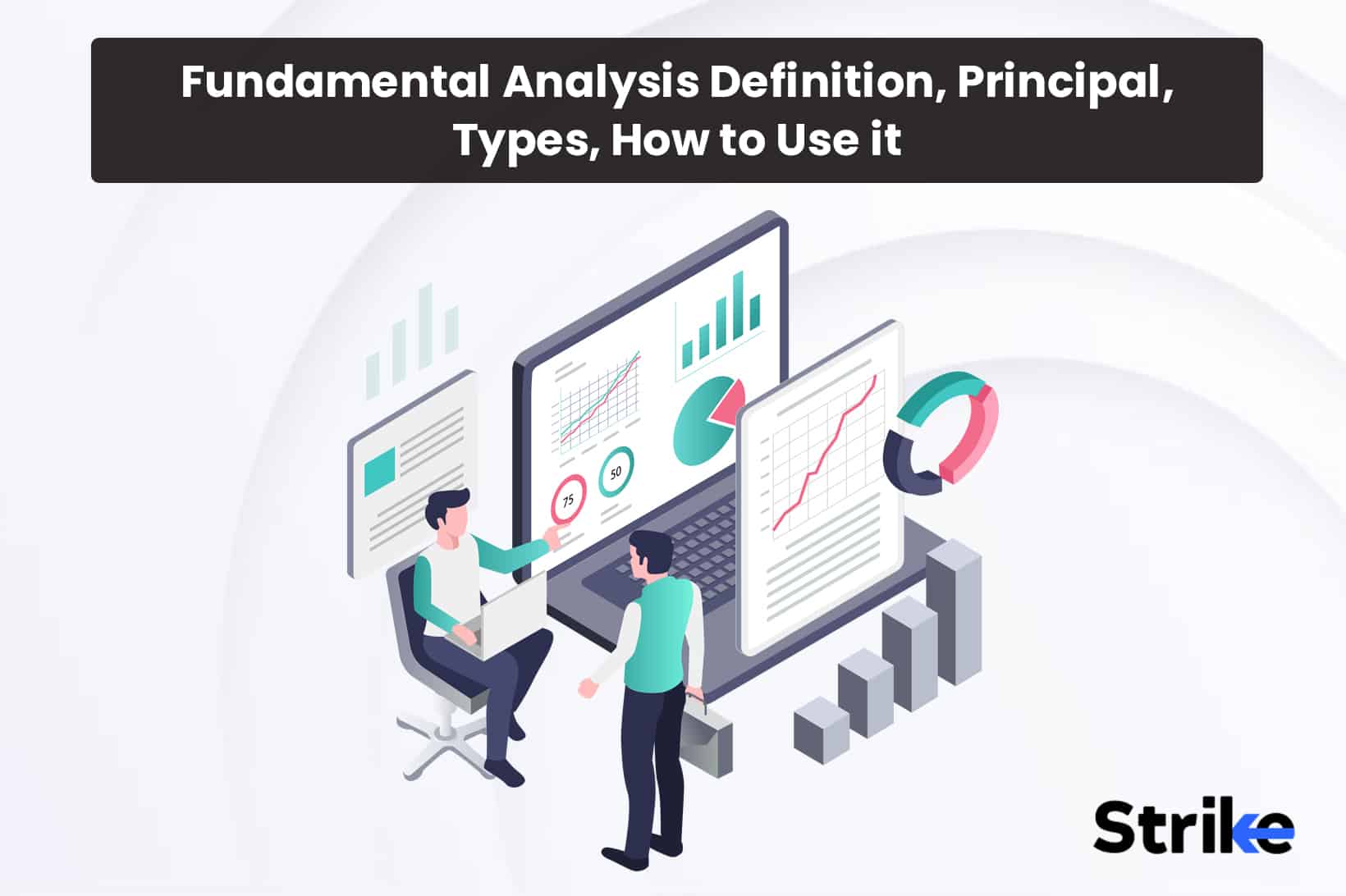


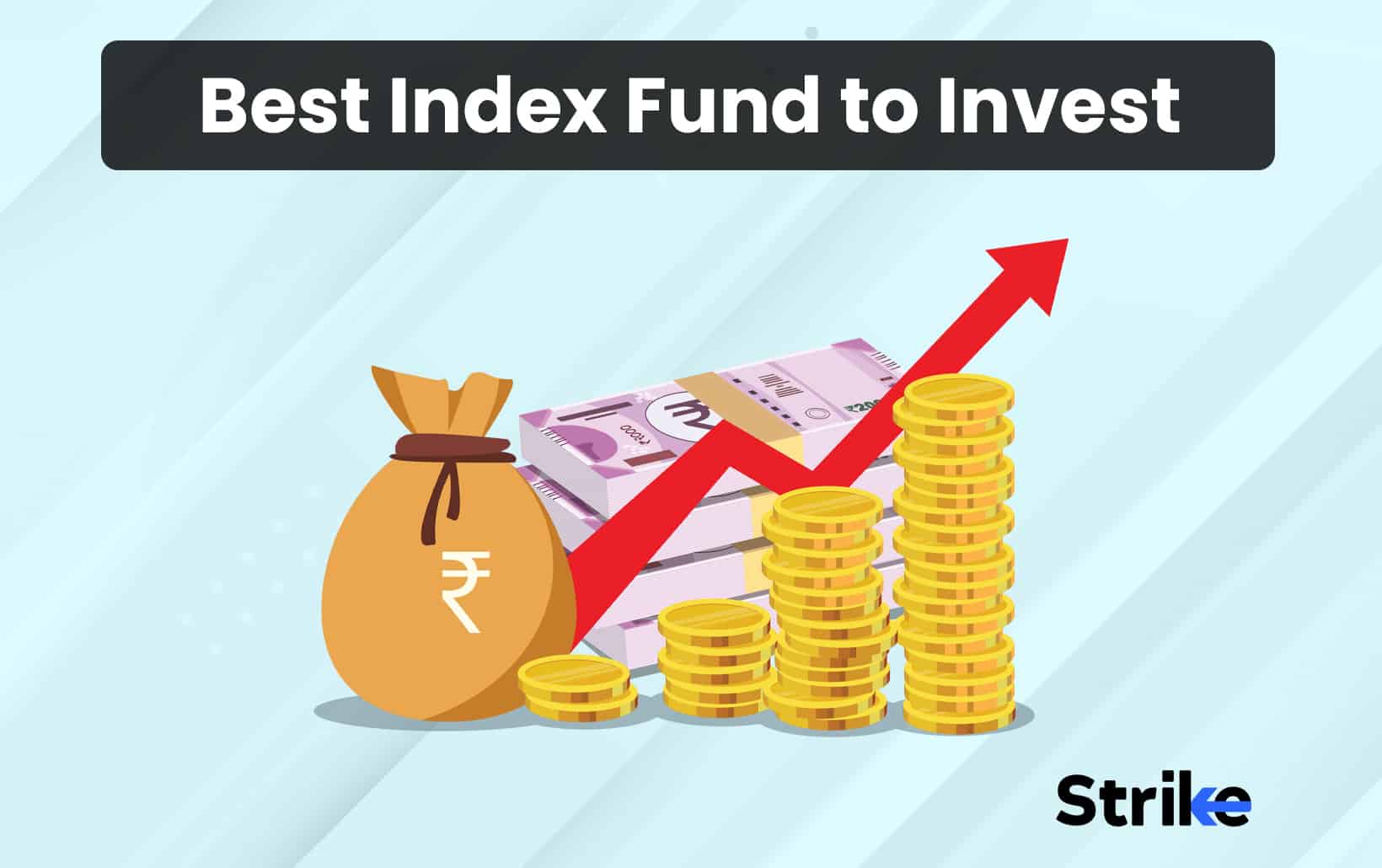



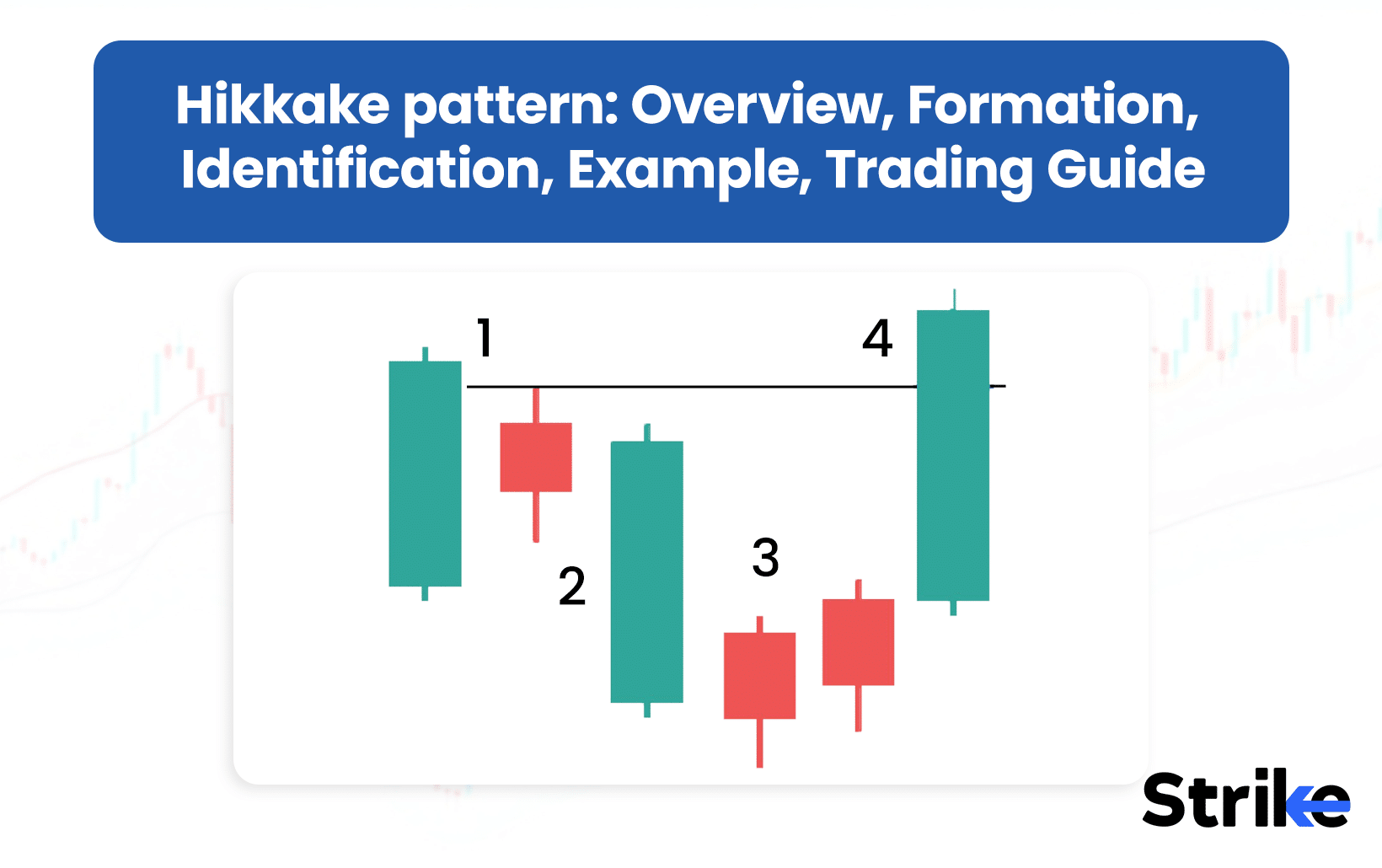
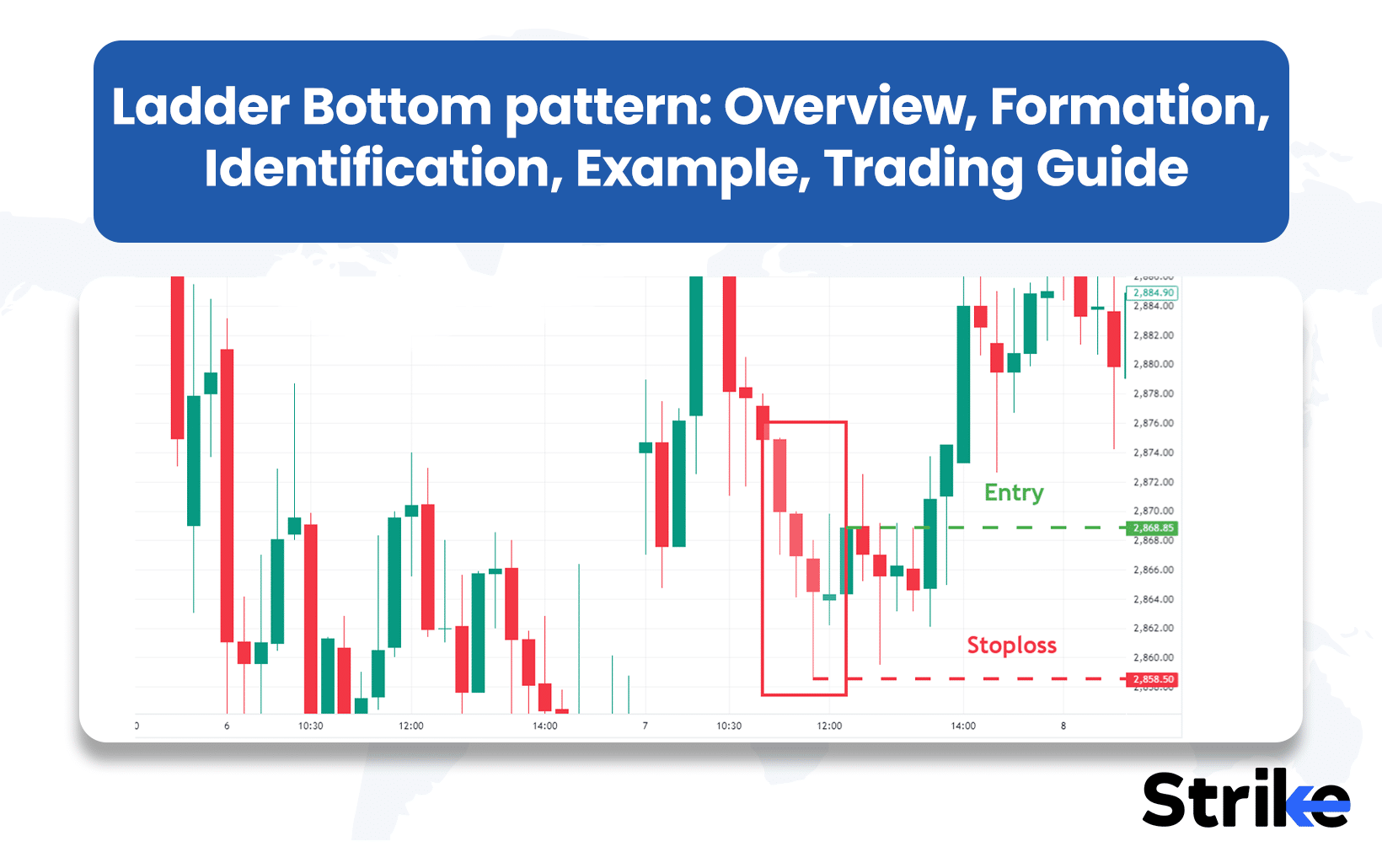




No Comments Yet.